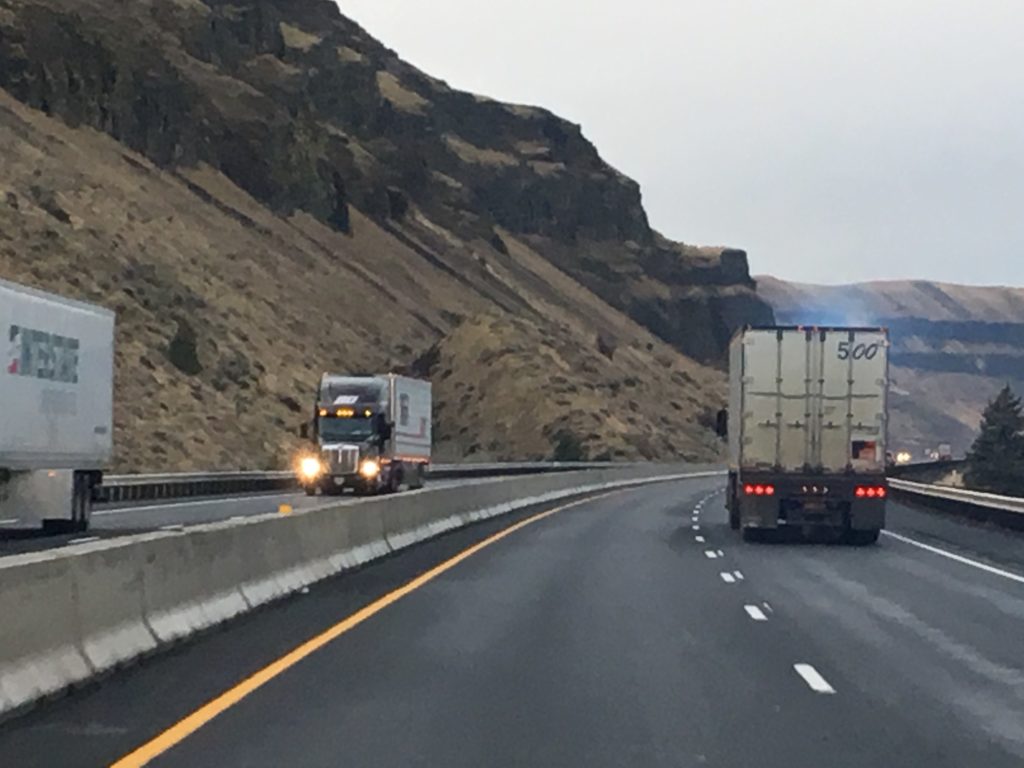I was recently asked about the laws governing truck parking along the highway. Last month an Oregon man died after crashing into a semi truck parked on the shoulder of OR Highway 201. There was a similar crash the month before, involving a mail truck and a parked big rig.
The law about parking big rigs on highway
Public highways are designed with a shoulder area suitable only for emergency stops. They are not designed to be parking spaces for semi-trucks or vehicles of any kind. You can only park on the shoulder of a highway in an emergency situation.
Commercial drivers and motor carriers are governed by the Federal Motor Carrier Safety Administration (FMCSA) or equivalent state-adopted laws.
One federal regulation, 49 CFR 392.22, specifically addresses the issue of big rigs parking on the shoulders of highways. Under the law, parking a commercial motor vehicle on the shoulder of the highway is permitted if the following rules and stipulations are followed.
Federal regulation 49 CFR 392.22:
- When stopping on the shoulder of a highway for a reason other than a traffic stop, the truck driver must immediately turn on the trailer’s hazard warning signal flashers.
- The parked truck driver must keep the vehicle’s flashers on until placing a warning device on the traffic side of the road.
- The driver must place warning devices as soon as possible, but no later than 10 minutes after stopping on the shoulder.
- Approved warning devices for big rigs parked on the shoulder include three bi-directional emergency reflective triangles, red flags, fuses and liquid-burning flares.
- Stopped truckers must place warning devices:
- On the traffic side four paces from the truck in the direction of oncoming traffic;
- At 40 paces from the big rig in the center of the shoulder in the direction of oncoming traffic; and
- At 40 paces in the direction away from oncoming traffic.
- If stopped on a shoulder within 500 feet of a hill, curve, or other obstruction, the driver must place a warning device in the direction of the obstruction, a distance of 100 to 500 feet from the stopped truck.
- The driver must not use emergency warning devices that produce flames if the vehicle is leaking gasoline or any other flammable or combustible liquid or gas, unless the signal is far enough away to prevent a fire or explosion.
Big rigs may stop on the shoulder of a highway as long as the driver carries out the above-mentioned protocols for warning other vehicles of the truck’s presence on the side of the road.
The truck driver must keep the warning devices in place during truck repairs, until the commercial vehicle can leave the shoulder.
Failure to fulfill following any of these requirements or other standard of care requirements can lead to liability for injuries or death caused by the stopped big rig.
So why do truck drivers park on the shoulder?
One of the reasons: truck stops are running out of space for them to park.
I have heard from drivers that if they arrive at the truck stops in the late afternoon or early evening, all the available parking spots will be gone.
Because there are strict rules regarding hours of service and required rest times, truckers can’t simply continue driving search for available truck parking.
Opinion: Add safe truck parking to prevent crashes
Drivers and their motor carriers need to plan routes and trips with consideration of parking and times of service.
Parking on the shoulder of a highway to rest or sleep most likely will constitute a violation of federal trucking regulations. Truck drivers should avoid it, as they could be liable for any injuries caused by their illegally parked vehicle.
– Attorney Kevin Coluccio
Kevin Coluccio is an experienced truck accident crash lawyer based in Seattle, Washington. He offers a free consultation for people involved in collisions with big rigs.





One Response
I never knew that a truck driver must keep their flashers on when they are on the side of the road. My brother is now in charge of a fleet of 18 wheelers and wants to make sure his fleet is protected and efficient. He should also make sure they have efficient towing ready if there is an accident.